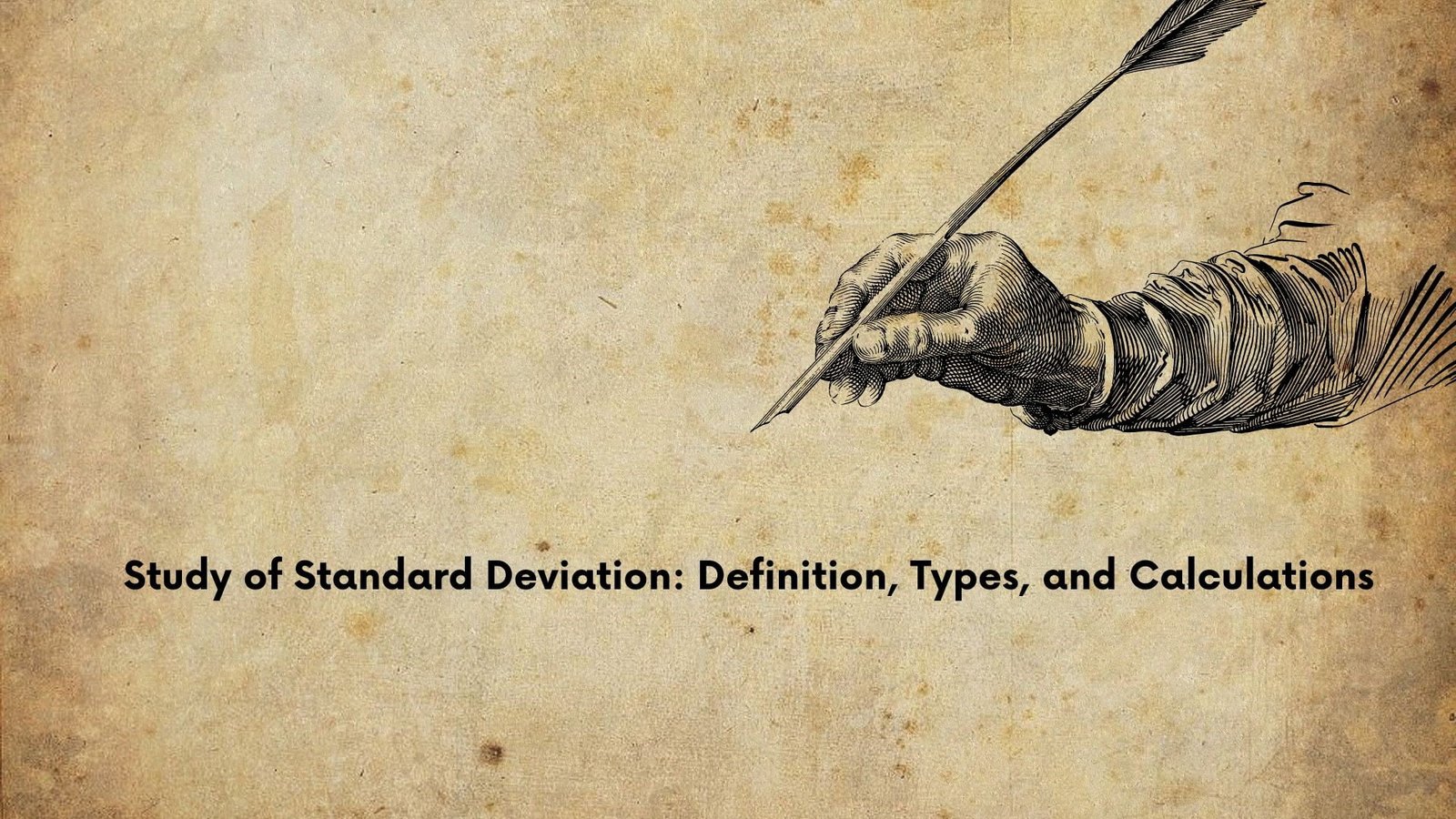Have you ever wondered how we measure the variability of data sets? How about comparing the variability and spread of data? The answer lies in a fundamental concept of statistics called standard deviation.
Standard deviation plays a fundamental role in statistics, to measure the variability, averages, spread of data, and data distribution. In this article, we will study the definition, types, and basic calculations of the term standard deviation.
What is the Standard Deviation?
The term standard deviation is a statistical measure that measures the amount of variation and dispersion in a data set. The term variation is the degree of change and diversity within the points of data observation.
Variation measures the extent to which individual data points differ from each other. It is an essential concept in data analysis and crucial for calculating meaningful results. While the term dispersion is the basics of the context of statistics.
It measures the spread of data values and measures the disappearance of the data values. It gives information about the variability of data points around the central values such as mean as well as median.
The term standard deviation measures the average distance of data points and the expected value with the help of variation or dispersion. A low value of the standard deviation indicates that the data observations are closely clustered around the expected value.
While the high value of the standard deviation indicates that the data observations are more spread out from the average value (larger dispersion or larger degree of variation). It can be evaluated by taking the square root of the result of the variance (another statistical measure).
Types of standard deviation
Here are two ways, types, or methods to find the standard deviation of the given observations.
| Name | Explanation | Formula |
| Sample Standard Deviation | In statistical measure, the sample std is a type of standard deviation that is used to measure the dispersion of a sample set of data. A sample is some estimated observations from a whole population of various terms. For example, calculating the weight of each person in the city is rather tough so we have to take the sample weights of some people from the whole to weights. The formula for measuring the sample std is: | s = √ (Σ(xi – x̄)² / (n – 1)) s = the sample stdΣ = the sigma symbolxi= each data point in the samplex̄ = the sample meann = the total number of data points in the sample |
| Population Standard Deviation | In statistical measures, the population std is a type of standard deviation that is used to calculate the dispersion of a population set of data. A population is the whole group of the larger population of various terms. For example, calculating the weight of each person in the city is the population estimation of weights. The formula for measuring the population std is: | σ = √ (Σ(xi – μ)² / N) σ = the population stdΣ = the sigma notationxi = each data point in the populationμ = the population meanN = the total number of data points in the population |
A standard deviation calculator is a helpful tool to find the STD of sample and population data values according to the above-mentioned formulas.
How to find the sample and population STD?
Example 1: population data
If the estimated weights of 12 persons are 15, 24, 22, 34, 36, 18, 26, 33, 25, 27, 30, and 31, find the measure of dispersion.
Solution
Step 1: Find the sum of the given weights of 12 persons and take the quotient of this sum by total numbers to find the mean.
| Weights of 12 persons | xi = 15, 24, 22, 34, 36, 18, 26, 33, 25, 27, 30, 31 |
| Addition of Weights | Σ xi = 15 + 24 + 22 + 34 + 36 + 18 + 26 + 33 + 25 + 27 + 30 + 31 Σ xi = 321 |
| population average | μ = (Σ xi) ÷ n μ = 321 ÷ 12 = 26.75 |
Step 2: Now minus each experimental value from the expected value and take the square of subtracted results.
| Experimental values | xi – μ | (xi – μ)2 |
| 15 | 15 – 26.5 = -11.75 | (-11.75)2 = 138.06 |
| 24 | 24 – 26.5 = -2.75 | (-2.75)2 = 7.56 |
| 22 | 22 – 26.5 = -4.75 | (-4.75)2 = 22.56 |
| 34 | 34 – 26.5 = 7.25 | (7.25)2 = 52.56 |
| 36 | 36 – 26.5 = 9.25 | (9.25)2 = 85.56 |
| 18 | 18 – 26.5 = -8.75 | (-8.75)2 = 76.56 |
| 26 | 26 – 26.5 = -0.75 | (-0.75)2 = 0.56 |
| 33 | 33 – 26.5 = 6.25 | (6.25)2 = 39.06 |
| 25 | 25 – 26.5 = -1.75 | (-1.75)2 = 3.06 |
| 27 | 27 – 26.5 = 0.25 | (0.25)2 = 0.06 |
| 30 | 30 – 26.5 = 3.25 | (3.25)2 = 10.56 |
| 31 | 31 – 26.5 = 4.25 | (4.25)2 = 18.06 |
Step 3: Now take the sum of squared differences of data observations from the expected value.
∑ (xi – μ)2 = 138.06 + 7.56 + 22.56 + 52.56 + 85.56 + 76.56 + 0.56 + 39.06 + 3.06 + 0.06 + 10.56 + 18.06
∑ (xi – μ)2 = 454.22
Step 4: Now divide the above-summed result by the total number of experimental values.
∑ (xi – μ)2 ÷ (n) = 454.22 ÷ 12
∑ (xi – μ)2 ÷ (n) = 37.854
Step 5: Now take the above result and find the square root of it.
√[∑ (xi – μ)2 ÷ (n)] = √37.854
√[∑ (xi – μ)2 ÷ (n)] = 6.153
Example-2: for sample data
If the estimated heights of 12 persons out of 100 are 5, 4, 2, 3, 6, 8, 4.6, 3.1, 2.5, 2.7, 3.4, and 4.1, find the measure of dispersion.
Solution
Step 1: Find the sum of the given heights of 12 persons and take the quotient of this sum by total numbers to find the mean.
| Sample Observations | xi = 5, 4, 2, 3, 6, 8, 4.6, 3.1, 2.5, 2.7, 3.4, 4.1 |
| Sum of sample | Σxi = 5 + 4 + 2 + 3 + 6 + 8 + 4.6 + 3.1 + 2.5 + 2.7 + 3.4 + 4.1 Σxi = 48.4 |
| Sample average | x̄ = (Σxi) ÷ n x̄ = 48.4 ÷ 12 = 4.033 |
Step 2: Now minus each experimental value from the expected value and take the square of subtracted results.
| Sample Observations | xi – x̄ | (xi – x̄)2 |
| 5 | 5 – 4.033= 0.97 | (0.97)2 = 0.94 |
| 4 | 4 – 4.033 = -0.03 | (-0.03)2 = 0.0009 |
| 2 | 2 – 4.033 = -2.03 | (-2.03)2 = 4.12 |
| 3 | 3 – 4.033 = -1.03 | (-1.03)2 = 1.06 |
| 6 | 6 – 4.033 = 1.97 | (1.97)2 = 3.88 |
| 8 | 8 – 4.033 = 3.97 | (3.97)2 = 15.76 |
| 4.6 | 4.6 – 4.033 = 0.57 | (0.57)2 = 0.32 |
| 3.1 | 3.1 – 4.033 = -0.93 | (-0.93)2 = 0.86 |
| 2.5 | 2.5 – 4.033 = -1.53 | (-1.53)2 = 2.34 |
| 2.7 | 2.7 – 4.033 = -1.33 | (-1.33)2 = 1.77 |
| 3.4 | 3.4 – 4.033 = -0.63 | (-0.63)2 = 0.40 |
| 4.1 | 4.1 – 4.033 = 0.07 | (0.07)2 = 0.0049 |
Step 3: Now take the sum of squared differences of data observations from the expected value.
∑ (xi – x̄)2 = 0.94 + 0.0009 + 4.12 + 1.06 + 3.88 + 15.76 + 0.32 + 0.86 + 2.34 + 1.77 + 0.40 + 0.0049
∑ (xi – x̄)2 = 31.45
Step 4: Now divide the above sum by n – 1.
∑ (Xi – x̄)2 ÷ (N – 1) = 31.45 ÷ 12 – 1
∑ (Xi – x̄)2 ÷ (N – 1) = 31.45 ÷ 11
∑ (Xi – x̄)2 ÷ (N – 1) = 2.861
Step 5: Now take the above result and find the square root of it.
√ [∑ (Xi – x̄)2 ÷ (N – 1)] = √2.861
√ [∑(Xi – x̄)2 ÷ (N – 1)] = 1.691
Join Our Whatsapp Group: Click Here
Final Words
Now you can study all the basics of the term standard form on this platform. You can take assistance from the solved examples of sample and population data to understand the manual calculations of this statistical technique.

